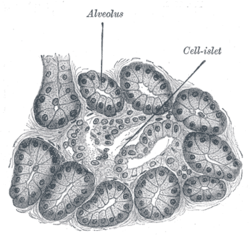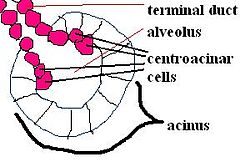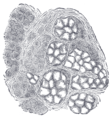- Alveolar gland
-
Alveolar gland 
Section of pancreas of dog. X 250. 
Centroacinar cells Code TH H2.00.02.0.03028 In contrast to tubular glands, in the second main variety of gland, the secretory portion is enlarged and the lumen variously increased in size. These are termed alveolar glands[1] (or saccular glands[2], or acinar glands[3], or acinous glands[4]).
Some sources draw a clear distinction between acinar and alveolar glands, based upon the shape of the lumen.[5]
A further complication in the case of the alveolar glands may occur in the form of still smaller saccular diverticuli growing out from the main sacculi. These are termed alveoli.
The term "tubulo-alveolar" (or "tubulo-acinar", or "compound tubulo-acinar", or "compound tubulo-alveolar"[6]) is used to describe glands that start out as branched tubular, and branch further to terminate in alveoli. This type of gland is found in the salivary glands[7], esophagus[8], and mammary glands.
The term "racemose gland"[9] is used to describe a "compound alveolar gland" or "compound acinar gland".[10]
Additional images
-
Section of portion of mamma.
References
- ^ Alveolar+gland at eMedicine Dictionary
- ^ Saccular+gland at eMedicine Dictionary
- ^ acinar
- ^ Acinous+gland at eMedicine Dictionary
- ^ Blue Histology - Epithelia and Glands
- ^ Histology at KUMC glands-glands17
- ^ Histology at KUMC glands-glands14 "Compound Tubulo- Alveolar"
- ^ MedEd at Loyola histo/practical/epithelium/hp1-28.html
- ^ Racemose+gland at eMedicine Dictionary
- ^ SIU SOM Histology GI
Epithelial cells Surface epithelium Simple squamous epithelium (Endothelium, Mesothelium)
Pseudostratified columnar epithelium (Respiratory epithelium)
Stratified squamous epithelium
Stratified cuboidal epithelium
Stratified columnar epithelium
Transitional epithelium/UrotheliumGland/
glandular epitheliumMechanismShapeSecretionComponentssee also Template:Epithelial neoplasms
This anatomy article is a stub. You can help Wikipedia by expanding it.



